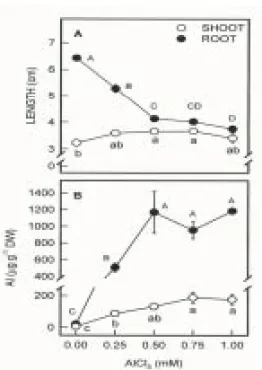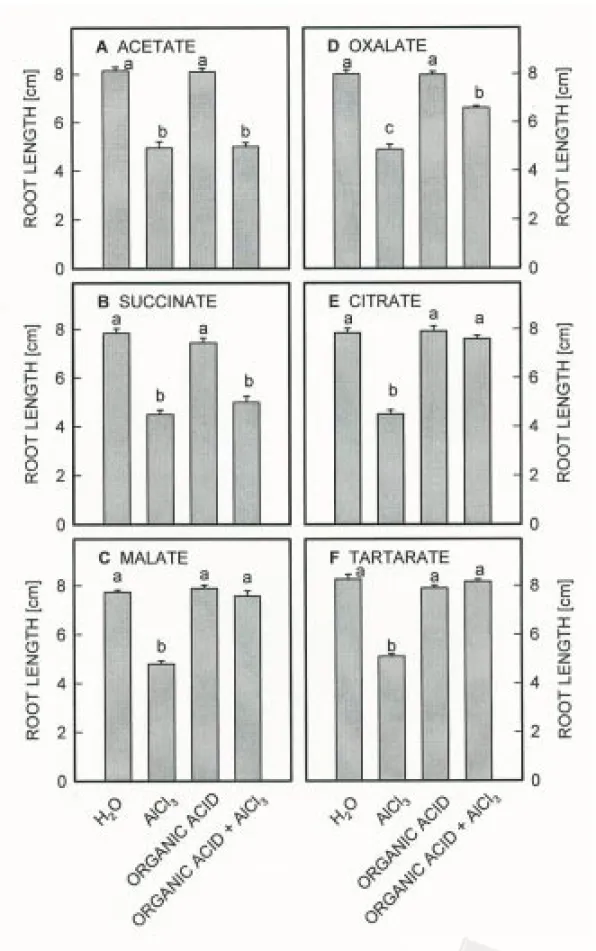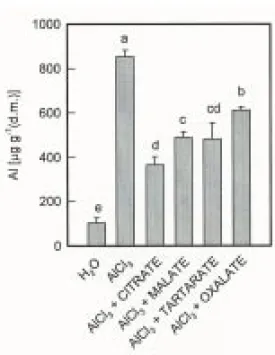Aluminum-inhibited root growth of rice seedlings 191
Reduction of Aluminum-inhibited Root Growth
of Rice Seedlings with Supplemental Calcium,
Magnesium and Organic Acids
Jen-Wu Wang and Ching Huei Kao*
Department of Agronomy, National Taiwan University, Taipei, Taiwan (ROC)
ABSTRACT
AlCl3 dissolved in half-strength Kimura B
nutrient solution was observed to be less effective in inhibiting root growth of rice seedlings than that dissolved in distilled water. Kimura B nutrient solution is composed of inorganic salts and citrate. Thus, we investigated the influence of inorganic salts and organic acids on AlCl3-inhibited root growth of rice seedlings. It
was observed that CaCl2, MgCl2, N aH2PO4, citrate,
malate, tartarate, and oxalate were able to reduce AlCl3-inhibited root growth of rice seedlings.
Results suggest that the effect of CaCl2, MgCl2,
and organic acids on AlCl3-inhibited root growth
is mediated through reducing Al level in roots of rice seedlings.
Key words:AlCl3,CaCl2, MgCl2, Organic acid, Rice,
Root growth. ෩Ͻ໗ȃ෩ϽᗢᇄԤᐠሖᄇ෩Ͻܚ ڙЫግ҂ऻਲ਼ҡߝϞኇ дਏݡȃଽශᎃ* 國立臺灣大學農藝學系 ᄢौ ෩Ͻྙ၌ܻј໔ϞУ؆Ъ
B
Ыેశ ڙЫግਲ਼ҡߝϞΨճܻ෩Ͻྙ၌ܻ ᇑᚤЫϛȄУ؆ЪB
Ыેశϱ֤Ԥฒᐠᢄ ᇄԤᐠሖȂӰԪרঈଆ෩Ͻ໗ȃ෩Ͻᗢᇄ Ԥᐠሖᄇ෩ϽܚڙЫግ҂ऻਲ਼ҡߝϞ ኇȄၐᡛ๖ݎᡗҰȂ෩Ͻ໗ȃ෩Ͻᗢȃᕥ ሖఱ໘ᇄԤᐠሖȞcitrate
ȃmalate
ȃtartarate
Ѕ
oxalate
ȟџ६ճ෩ϽܚڙЫግਲ਼Ϟ ҡߝȄ෩Ͻ໗ȃ෩ϽᗢᇄԤᐠሖϞਝᔖ߽င ҥڏ६ճЫግਲ਼ϱϞ֤໔ܚഅԙȄ ᜰᗤຠȈ෩Ͻȃ෩Ͻ໗ȃ෩ϽᗢȃԤᐠሖȃ Ыግȃਲ਼ҡߝȄ INTRODUCTIONAluminum (Al) does not exert any known function in plant metabolism and belongs to the non-essential metals. Under neutral soil conditions, it exists in the non-phytotoxic insoluble form, whereas acidification of soil and soil water below pH 4.5 dramatically enhances release of the phytotoxic aluminum ion (MacDonald and Martin 1988). Since acid soils occupy up to 40% of world’s arable land (Kochian 1995), Al phytotoxicity may be considered as one of the major limiting factors of crop productivity in the world (Matsumoto 2000). The primary effect of Al toxicity is the inhibition of root growth; however, the mechanisms involved in this toxicity are far from clear (Matsumoto 2000).
Calcium (Ca) plays important and crucial roles in plant metabolism (Kauss 1987), development (Helper and Wayne 1985) and signal transduction (Sanderset al.2002). The role of Ca in Al toxicity has been extensively examined (Foy 1988, Rengel 1992, Rengel and Zhang 2003). Al *߬հޱ, kaoch@ccms.ntu.edu.tw
ገРȈ2004ԑ4Т27Р
ڧРȈ2004ԑ5Т11Р
հސȃᕗცᇄҡސၥଉ 1:191-198 (2004)
Crop, Environment & Bioinformatics1:191-198 (2004) 189 Chung-Cheng Rd., Wufeng, Taichung Hsien 41301, Taiwan (ROC)
Aluminum-inhibited root growth of rice seedlings 193
Fig. 1. Effect of AlCl3on the growth of roots and shoot
and the level of Al in roots and shoot of rice seedlings. Two-day-old rice seedlings were treated with AlCl3(dissolved in distilled water,
pH 4.0) for 2 days. Values with the same letter are not significantly different at P < 0.05,
according to Duncan’s multiple range test.
Fig. 2. Effect of AlCl3and pH on root growth and Al
level in roots of rice seedlings. Two-day-old rice seedlings were treated with 0.5 mM AlCl3
at pH 4.0and 7.0for 2 days. Values with the same letter are not significantly different atP
< 0.05, according to Duncan’s multiple range test.
When root growth of rice seedlings treated with AlCl3 in distilled water was compared with
that in half-strength Kimura B solution, it was observed that the former was more effective in root growth inhibition and had higher Al level in roots than the latter (Fig. 3A and Fig.4). However, the medium pH of the treatment that AlCl3
dissolved in water was higher than that of AlCl3
dissolved in Kimura B solution (Fig. 3B). Thus, medium pH cannot be used to explain the less root growth inhibition of rice seedlings treated with AlCl3in Kimura B solution compared to that
treated with AlCl3in distilled water.
Kimura B solution is composed of inorganic salts, such as K+, N a+, Ca2+, Mg2+, Mn2+,
phosphorus, Fe2+, and H3BO3(Chu and Lee 1989).
These inorganic salts may interfere with the uptake of Al by rice roots. If this is indeed the case, then inorganic salts are expected to reduce Al-inhibited growth. Figures 5B, 5F, and 5G show that CaCl2, MgCl2and phosphorus were effective
in reducing root growth inhibition caused by AlCl3 dissolved in H2O. However, KCl, NaCl,
Fig. 3. Effect of AlCl3on root growth of rice seedlings
and medium pH. Two-day-old seedlings were treated with AlCl3dissolved in distilled water
(pH 4.0) or dissolved in nutrient solutions (pH 4.0) for 2 days. Nutrient solution represents half-strength Kimura B solution. Asterisks indicate values that are significantly different at P < 0.05 level by Student’s t-test when
Fig. 4. Effect of AlCl3 on Al level in roots of rice
seedlings. Two-day-old seedlings were treated with AlCl3dissolved in distilled water
(0.5 mM, pH 4.0) or AlCl3 dissolved in
nutrient solution (0.5 mM, pH 4.0) for 2 days. Nutrient solution represents half-strength Kimura B solution. Values with the same letter are not significantly different atP< 0 .0 5,
according to Duncan’s multiple range test. MnCl2, FeSO4, andH3BO3 hadno effect on
Al-inhibitedroot growth of rice seedlings (Figs. 5A, 5C, 5D, 5E, and5H).
Figure 6A shows that the increase in Al level in roots causedby AlCl3 was reduced by CaCl2
andMgCl2. Ca level was observedto be higher in
roots treatedwith CaCl2 together with AlCl3
comparedwith roots treatedwith AlCl3alone (Fig.
6B). Similarly, Mg level was higher in roots treatedwith MgCl2 together with AlCl3 when
comparedwith AlCl3 alone (Fig. 6C). Compared
with water control, AlCl3 treatment did not
reduce Ca or Mg level in roots of rice seedlings (Figs. 6B and6C).
Since Kimura B solution is also composedof citrate, thus we examinedthe effects of several organic acids (such as acetate, succinate, malate, oxalate, citrate, andtartarate) on growth inhibition of roots causedby AlCl3(Fig. 7). When
roots were treatedwith AlCl3 andthese organic
acids, it was observed that malate, oxalate, citrate, andtartarate were effective in reducing Al-inhibitedroot growth (Figs. 7C, 7D, 7E, and 7F). However, acetate andsuccinate hadno effect on Al-inhibitedroot growth (Figs. 7A and7B). Figure 8 shows that citrate, malate, tartarate, and oxalate were able to reduce the increase in Al level in roots causedby AlCl3.
Fig. 5. Effect of KCl, NaCl, CaCl2, MgCl2, NaH2PO4,
FeSO4, and H3BO3on Al-inhibited root growth
of rice seedlings. Two-day-old seedlings were treated with various salts in the presence or absence of AlCl3(0.5 mM, pH 4.0) for 2 days.
Values with the same letter are not significantly different atP< 0.05, according to
Duncan’s multiple range test.
DISCUSSION
In this study, we found that supplement of CaCl2 andMgCl2 significantly ameliorate growth
inhibition of rice roots causedby AlCl3 (Figs. 5B
and5F). These results are consistent with the general contention that Ca2+andMg2+are able to
Aluminum-inhibitedroot growth of rice seedlings 195 reduce the toxic effects of Al (Foy 1988, Rengle
1992, Rengle andZhang 2003). AlCl3treatment
results in an increase in Al level in roots of rice seedlings (Figs. 1B, 2B, and 6A). This increase in Al level couldbe reducedby the presence of CaCl2andMgCl2in the medium solution (Fig. 6A).
Thus, the alleviative effect of Ca2+ or Mg2+ is
mostly likely attributable to Ca2+- or Mg2+
-reduced Al uptake of rice roots.
It has been shown that the symptoms of Al toxicity resemble those of Ca2+or Mg2+deficiency
(Foy 1988). This does not seem to be the case in the roots of rice seedlings, because AlCl3
treatment hadno effect on Ca andMg level (Figs. 6B and6C).
Increasing the phosphorus supply has been reportedto exert certain roles in eliminating Al toxicity (Foy 1988, Tan andKeltjens 1990a, 1990b). We also observed that addition of NaH2PO4 was
able to reduce Al-inhibited root growth of rice seedlings (Fig. 5G). Lenoble et al. (1996a, b) demonstrated that supplemental B prevented Al inhibition of root growth of alfalfa. However, we were unable to show the alleviative effect of H3BO3 on Al-inhibitedgrowth of rice seedlings
(Fig. 5H). It appears that Al toxicity in rice roots may not induce B deficiency. Although interactions of Al with Fe, Mn, andK has previously been reported(Foy 1988), we foundno effect of FeSO4,
MnCl2, andKCl on Al-inhibitedroot growth of rice
seedlings (Figs. 5A, 5C, and 5D).
Organic acids are known to detoxify Al toxicity (Ma 2000, Maet al.2001). Basedon pure solution experiments, Hue et al. (1986) classified citrate, oxalate, andtartarate as strong Al detoxifiers, malate and malonate as moderate Al detoxifiers, and acetate and succinate were weak Al detoxifiers. Here, among six organic acids tested, we show that malate, citrate, and tartarate were the most effective, andoxalate was moderate effective in reducing Al-inhibited root growth of rice seedlings (Figs. 7C, 7D, 7E, and 7F). However, acetate andsuccinate were observedto be ineffective in detoxify Al toxicity in rice seedlings (Figs. 7A and 7B). Citrate, malate, oxalate, andtartarate treatments significantly reduced the increase of Al level in roots of rice seedlings (Fig. 8). These results are consistent with the general contention that organic acids
detoxify Al in root medium solution by chelating Al (Ma 2000, Maet al.2001).
In conclusion, the presence of calcium, magnesium, phosphorus, andcitric acidin Kimura B seems to be the reasons that AlCl3
dissolved in Kimura B solution is less effective in inhibiting root growth of rice seedlings than AlCl3
dissolved in distilled water.
Fig. 6. Effect of AlCl3,CaCl2, and MgCl2on the levels
of Al, Ca, and Mg in roots of rice seedlings. Two-day-old seedlings were treated with distilled water (pH 4.0), 0.5 mM AlCl3 (pH
4.0), 0.5 mM AlCl3+ 5mM CaCl2(pH 4.0) or 0.5
mM . AlCl3+ 5mM MaCl2(pH 4.0) for 2 days.
Values with the same letter are not significantly different atP< 0.05, according to
Fig. 7. Effect of organic acids on AlCl3-inhibited root growth of rice seedlings. Two-day-old seedlings were
treated with various organic acids (0.5 mM, pH 4.0) in the presence or absence of AlCl3(0.5 mM, pH 4.0)
for 2 days. Values with the same letter are not significantly different atP< 0.05, according to Duncan’s
Aluminum-inhibited root growth of rice seedlings 197
Fig. 8. Effect of AlCl3and organic acids on Al level in
roots of rice seedlings. Two-day-old seedlings were treated with distilled water (pH 4.0), 0.5 m M AlCl3(pH 4.0), 0.5 mM AlCl3and 0.5 mM
organic acids (pH 4.0) for 2 days. Values with the same letter are not significantly different at P < 0.05, according to Duncan’s multiple
range test.
REFERENCES
Alva AK, DG Edwards (1990)Response of lupin cultivars to concentration of calcium and activity of aluminum in dilute nutrient solutions.J. Plant Nutr. 13:57-76.
Alva AK, CJ Asher, DG Edwards (1986)The role of calcium in alleviating aluminum toxicity. Aust. J. Agric. Res. 37:375-382.
Brady DJ, DG Edwards, CJ Asher, LC Bell (1993) Calcium amelioration of aluminum toxicity effects on root hair development in soybean [Glycine max (L)Merr.]. New Phytol. 123: 531-538.
Chu C, TM Lee (1989)The relationship between ethylene biosynthesis and chilling tolerance in seedlings of rice (Oryza sativa).Bot. Bull. Acad. Sin. 30:263-273.
Clark RB (1977)Effect of aluminum on growth and mineral elements of Al-tolerant and Al-intolerant corn.Plant Soil 47:653-662. Foy CD (1988)Plant adaptation to acid,
aluminum-toxic soils.Commun. Soil Sci. Plant
Anal. 19:959-987.
Foy CD, RL Chaney, MC White (1978)The physiology of metal toxicity in plants. Annu. Rev. Plant Physiol. 29:511-566.
Grimme H (1983)Aluminum induced magnesium deficiency in oats.Z. Pflanzenevnähr. Bodenk. 146:666-676.
Hecht-Buchholz CH, J Schuster (1987)Responses of Al-tolerant Dayton and Al-sensitive Kearney barley cultivars to calcium and magnesium during Al stress.Plant Soil 99:47-61.
Helper PK, RO Wayne (1985)Calcium and plant development. Annu. Rev. Plant Physiol. 36:397-439.
Hue NV, GR Craddock, F Adams (1986)Effect of organic acids on aluminum toxicity in subsoil. Soil Sci. Soc. Am. J. 50:28-34.
Jones JS (1961)Aluminum uptake and toxicity in plants.Plant Soil 13:292-310.
Kauss H (1987)Some aspects of
calcium-dependent regulation in plant metabolism. Annu. Rev. Plant Physiol. 38:47-72.
Kochian LV (1995)Cellular mechanism of aluminum toxicity and resistance in plants. Annu. Rev. Plant Physiol. Plant Mol. Biol. 46:237-260.
Kinraide TB, DR Parker (1987)Cation amelioration of aluminum toxicity in wheat. Plant Physiol. 83:546-551.
Lenoble ME, DG Blevins, RE Sharp, BG Cumbie (1996a)Prevention of aluminum toxicity with supplement boron. I. Maintenance of root elongation and cellular structure. Plant Cell Environ. 19:1132-1142.
Lenoble ME, DG Blevins, RJ Miles (1996b) Prevention of aluminum toxicity with supplement boron. II. Stimulation of root growth in an acidic, high-aluminum subsoil. Plant Cell Environ. 19:1143-1148.
Ma JF (2000)Role of organic acids in detoxification of aluminum in higher plants. Plant Cell Physiol. 41:383-390.
Ma JF, PR Ryan, E Delhaize (2001)Aluminum tolerance in plants and complexing role of
organic acid.Trends Plant Sci. 6:273-278. MacDonald T, RB Martin (1988)Al ion in
biological systems.Trends Biol. Sci. 13:15-19. Matsumoto H (2000)Cell biology of aluminum
toxicity and tolerance in higher plants.Int. Rev. Cytol. 200:1-46.
Noble AD, ME Sumner (1988)Calcium and Al interactions and soybean root growth in nutrient solutions. Commun. Soil Sci. Plant Anal. 19:1119-1131.
Rengel Z (1990)Comparative Al3+ inhibition of
net Mg2+ uptake by intact Lolium multiflorum
roots. II. Plant age effects. Plant Physiol. 93:1261-1267.
Rengel Z (1992)Role of calcium in aluminum toxicity.New Phytol. 121:499-513.
Rengel Z, DL Robinson (1989a)Aluminum effects on growth and macronutrient uptake in annual rye grass.Agron. J. 81:208-215.
Rengel Z, DL Robinson (1989b)Comparative Al3+
inhibition of net Mg2+uptake by intactLolium
multiflorum roots. I. Kinetics. Plant Physiol. 91:1407-1413.
Rengel Z, Z-H Zhang (2003)Role of dynamic of intracellular calcium in aluminum-toxicity syndrome.New Phytol. 159:295-314.
Rhue RD, CO Grogan (1977)Screening corn for aluminum tolerance using different Ca and Mg concentrations.Agron. J. 69:755-760.
Sanders D, J Pelloux, C Brownlee, JF Harper (2002) Calcium at the crossroad of signaling. Plant
Cell 14:S401-S407.
Sanzonowicz C, TJ Smyth, DW Israel (1998) Calcium alleviation of hydrogen and aluminum inhibition of soybean root extension from lime soil into acid subsurface solutions.J. Plant Nutri. 21:785-804.
Silva IR, TJ Smyth, DW Israel, CD Raper, TW Ruffy (2001a)Magnesium is more efficient than calcium in alleviating aluminum rhizotoxicity in soybean and its ameliorative effect is not explained by the Gouy-Chapman-Stern model. Plant Cell Physiol. 42:538-545.
Silva IR, TJ Smyth, DW Israel, CD Raper, TW Ruffy (2001b)Magnesium ameliorates aluminum rhizotoxicity in soybean by increasing citric acid production and exudation by roots.Plant Cell Physiol. 42:546-554. Tan K, WG Keltjens (1990a)Interaction between
aluminum and phosphorus in sorghum plants. I. Studies with the aluminum sensitive sorghum genotype TAM428. Plant Soil 124:15-23.
Tan K, WG Keltjens (1990b)Interaction between aluminum and phosphorus in sorghum plants. II. Studies with the aluminum tolerant sorghum genotype SCO283. Plant Soil 124:25-23.
Tan K, WG Keltjens, GR Findenegg (1992) Aluminum toxicity with sorghum genotype in nutrient solutions and its amelioration by magnesium. Z. Pflanzenevnähr. Bodenk. 155:81-86.




